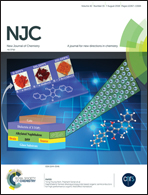Zinc(ii) complexes with uncommon aminal and hemiaminal ether derivatives: synthesis, structure, phosphatase activity and theoretical rationalization of ligand and complex formation†
Abstract
Condensation of N-(2-hydroxyethyl)ethylenediamine and pyridine-2-carbaldehyde in the presence of ZnX2 salts (X = ClO4−, Cl−, Br−, I−) generates four complexes, namely, [ZnL1Cl](ClO4) (1), [ZnL1Cl][ZnCl3(H2O)]·2H2O (2), [ZnL1Br][ZnBr3(H2O)]·2H2O (3), and [Zn(L2)3]I2 (4), where L1 and L2 are aminal and hemiaminal ether derivatives, i.e., (E)-N-((pyridine-2-yl)methylene)-2-((2-pyridine-2-yl)oxazolidin-3-yl)ethanamine and 2-(2-pyridin-2-yl-imidazolidin-1-yl)-ethanol, respectively. No complex with the expected Schiff-base ligand (E)-2-(2-(pyridin-2-ylmethyleneamino)ethylamino)ethanol (L) or with 2-(2-pyridyl-3-(2-hydroxyethyl))oxazolidine (L3) was obtained. The structures of complexes 1, 3, and 4 have been elucidated by single crystal X-ray diffraction. All the complexes have been characterized by detailed NMR (1H, 13C and DEPT-135) and ESI-MS analyses, indicating retention of solid state structures in the solution phase. Complex 1 deserves special mention as during its formation, the ClO4− ion undergoes reduction to Cl− and thus, it forms a mixed anionic ligand complex. Thorough DFT calculations have been performed at the BP86-D3/def2-TZVP level of theory to rationalize the ligand and complex formation. The calculations suggest that the aminal form (L1) is the most favored species followed by the Schiff-base, whereas the hemiaminal ether form (L3) is the least preferred one. The role of halides during the formation of the monoanionic [ZnX3(H2O)]− species is crucial, and the achieved complex is highly favored when X = Cl and disfavored for X = I; this trend has been rationalized by the DFT calculations. The phosphatase activities of the complexes have been investigated, and their efficiencies follow the order 2 > 1 > 3 > 4.



 Please wait while we load your content...
Please wait while we load your content...